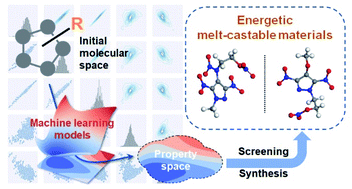Accelerating the discovery of energetic melt-castable materials by a high-throughput virtual screening and experimental approach†
Abstract
With the growth of chemical data, computation power and algorithms, machine learning-assisted high-throughput virtual screening (ML-assisted HTVS) is revolutionizing the research paradigm of new materials. Herein, a combined ML-assisted HTVS and experimental approach was applied to accelerate the search for energetic melt-castable materials with promising properties. The ML-assisted HTVS system is composed of high-throughput molecular generation (in a heuristic enumeration method) and five machine learning-based property prediction models (including density, melting point, decomposition temperature, detonation velocity, and detonation pressure). Using this system, we rapidly targeted 136 promising candidates from a generated molecular space containing 3892 molecules. With extensive efforts on experimental synthesis, eight new energetic melt-castable materials (MC-1 to MC-8) were obtained, and their measured properties were in good agreement with the predicted results. This work verifies the effectiveness of the combined ML-assisted HTVS and experimental approach for the accelerated discovery of energetic melt-castable materials.



 Please wait while we load your content...
Please wait while we load your content...